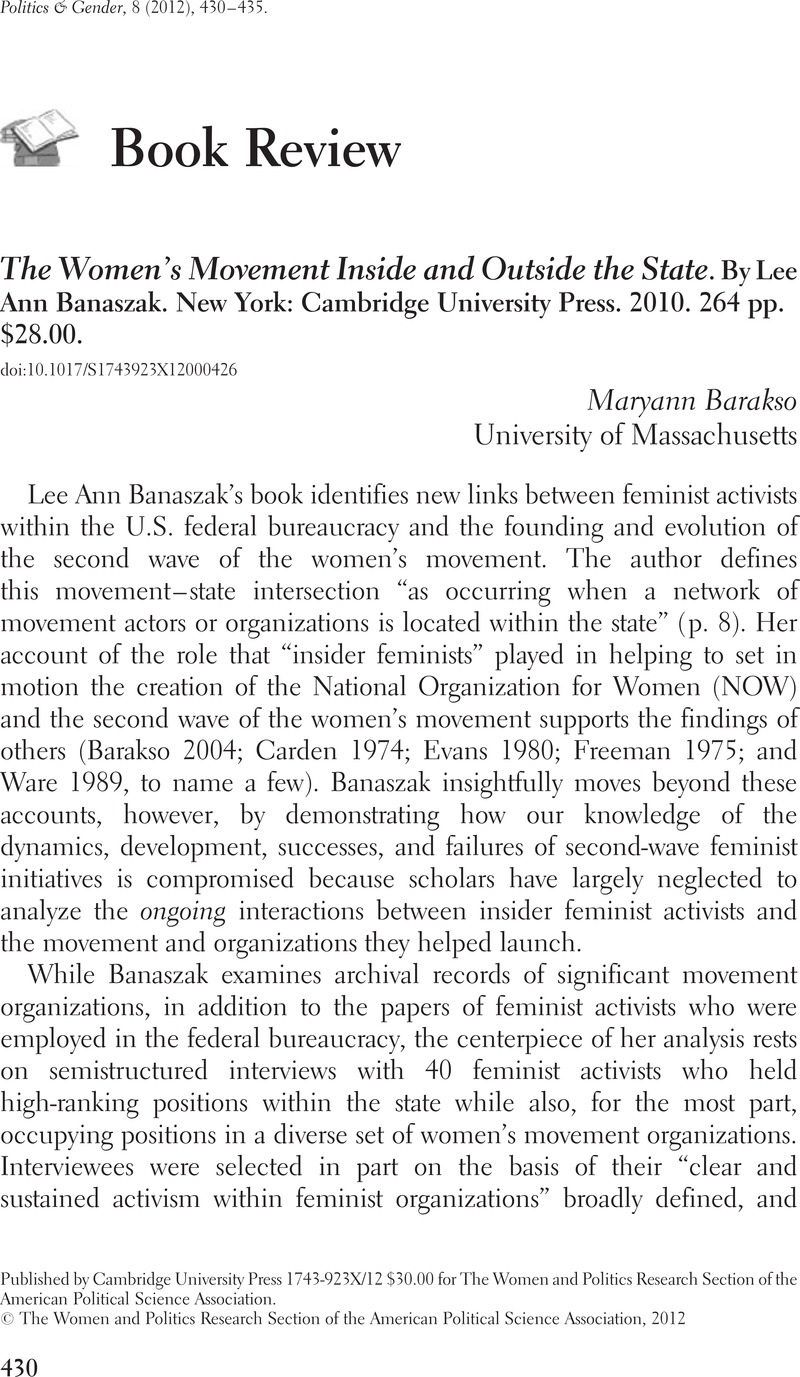No CrossRef data available.
Article contents
The Women's Movement Inside and Outside the State. By Lee Ann Banaszak. New York: Cambridge University Press.2010. 264 pp. $28.00.
Review products
The Women's Movement Inside and Outside the State. By Lee Ann Banaszak. New York: Cambridge University Press.2010. 264 pp. $28.00.
Published online by Cambridge University Press: 22 August 2012
Abstract
An abstract is not available for this content so a preview has been provided. Please use the Get access link above for information on how to access this content.

- Type
- Book Review
- Information
- Copyright
- Copyright © The Women and Politics Research Section of the American Political Science Association 2012
References
REFERENCES
Barakso, Maryann. 2004. Governing Now: Grassroots Activism in the National Organization for Women. Ithaca, NY: Cornell University Press.CrossRefGoogle Scholar
Bender, Jonathan, and Moe, Terry M.. 1985. “An Adaptive Model of Bureaucratic Politics.” American Political Science Review 79 (3): 755–74.CrossRefGoogle Scholar
Berry, Jeffrey. 1999. The New Liberalism: The Rising Power of Interest Groups. Washington, DC: Brookings Institution.Google Scholar
Carden, Maren Lockwood. 1974. The New Feminist Movement. New York: Russell Sage Foundation.Google Scholar
Carpenter, Daniel P. 2001. The Forging of Bureaucratic Autonomy: Reputations, Networks, and Policy Innovation in Executive Agencies, 1862–1928. Princeton: Princeton University Press.Google Scholar
Evans, Sara M. 1980. Personal Politics: The Roots of Women's Liberation in the Civil Rights Movement and the New Left. New York: Vintage Books.Google Scholar
Heclo, Hugh. 1978. “Issue Networks and the Executive Establishment.” In Public Policy: The Essential Readings, ed. Theodoulou, Stella Z. and Cahn, Matthew A.. Upper Saddle River, NJ: Prentice Hall.Google Scholar
Lavertu, Stephane. 2010. “Political Conflict, Policy Volatility, and the Insulation of Policy Bargains.” Presented at the Annual Meeting of the Midwest Political Science Association, Chicago.Google Scholar
Lawless, Jennifer L., and Fox, Richard L. 2010. It Still Takes a Candidate: Why Women Don't Run for Office. New York: Cambridge University Press.CrossRefGoogle Scholar
Miller, Gary L., and Moe, Terry M.. 1983. “Bureaucrats, Legislators, and the Size of Government.” American Political Science Review 77 (2): 297–322.CrossRefGoogle Scholar
Roberts, Nancy. 2004. “Public Deliberation in an Age of Direct Citizen Participation.” American Review of Public Administration 34 (4): 315–53.CrossRefGoogle Scholar
Sabatier, Paul. 1987. “Knowledge, Policy-Oriented Learning, and Policy Change: An Advocacy Coaltion Framework.” Knowledge: Creation, Diffusion, Utilization 8 (June): 649–92.CrossRefGoogle Scholar
Sanbonmatsu, Kira. 2006. Where Women Run: Gender and Party in the American States. Ann Arbor: University of Michigan Press.CrossRefGoogle Scholar
Strolovitch, Dara. 2007. Affirmative Advocacy: Race, Class, and Gender in Interest Group Politics. Chicago: University of Chicago Press.CrossRefGoogle Scholar
Weldon, S. Laurel. 2011. When Protest Makes Policy: How Social Movements Represent Disadvantaged Groups. Ann Arbor: University of Michigan Press.CrossRefGoogle Scholar
Wood, B. Dan, and Bohte, John. 2004. “Political Transaction Costs and the Politics of Administrative Design.” Journal of Politics 66 (1): 176–202.CrossRefGoogle Scholar


